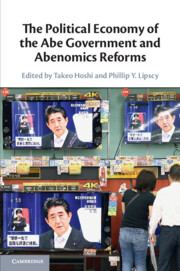Book contents
- The Political Economy of the Abe Government and Abenomics Reforms
- The Political Economy of the Abe Government and Abenomics Reforms
- Copyright page
- Dedication
- Contents
- Figures
- Tables
- Contributors
- Acknowledgments
- Abbreviations
- Part I Introduction
- Part II Political Context
- Part III Macroeconomic Policy
- Part IV Third Arrow of Abenomics
- 10 Abe’s Slight Left Turn
- 11 Abe’s Womenomics Policy
- 12 Corporate Governance Reforms under Abenomics
- 13 Abenomics and Japan’s Entrepreneurship and Innovation
- 14 Japanese Agricultural Reform under Abenomics
- 15 The Politics of Energy and Climate Change in Japan under the Abe Government
- Part V Foreign Policy
- Index
- References
11 - Abe’s Womenomics Policy
Did It Reduce the Gender Gap in Management?
from Part IV - Third Arrow of Abenomics
Published online by Cambridge University Press: 05 February 2021
- The Political Economy of the Abe Government and Abenomics Reforms
- The Political Economy of the Abe Government and Abenomics Reforms
- Copyright page
- Dedication
- Contents
- Figures
- Tables
- Contributors
- Acknowledgments
- Abbreviations
- Part I Introduction
- Part II Political Context
- Part III Macroeconomic Policy
- Part IV Third Arrow of Abenomics
- 10 Abe’s Slight Left Turn
- 11 Abe’s Womenomics Policy
- 12 Corporate Governance Reforms under Abenomics
- 13 Abenomics and Japan’s Entrepreneurship and Innovation
- 14 Japanese Agricultural Reform under Abenomics
- 15 The Politics of Energy and Climate Change in Japan under the Abe Government
- Part V Foreign Policy
- Index
- References
Summary
This chapter uses Japanese governmental microdata, the Labor Force Survey and the Basic Survey on Wage Structure, to look at the change in the gender wage gap and in the probability of females becoming managers. I found a higher probability of females becoming managers during the Abe administration, though there is still a large gap in promotion to management.
Keywords
- Type
- Chapter
- Information
- Publisher: Cambridge University PressPrint publication year: 2021
References
- 3
- Cited by

